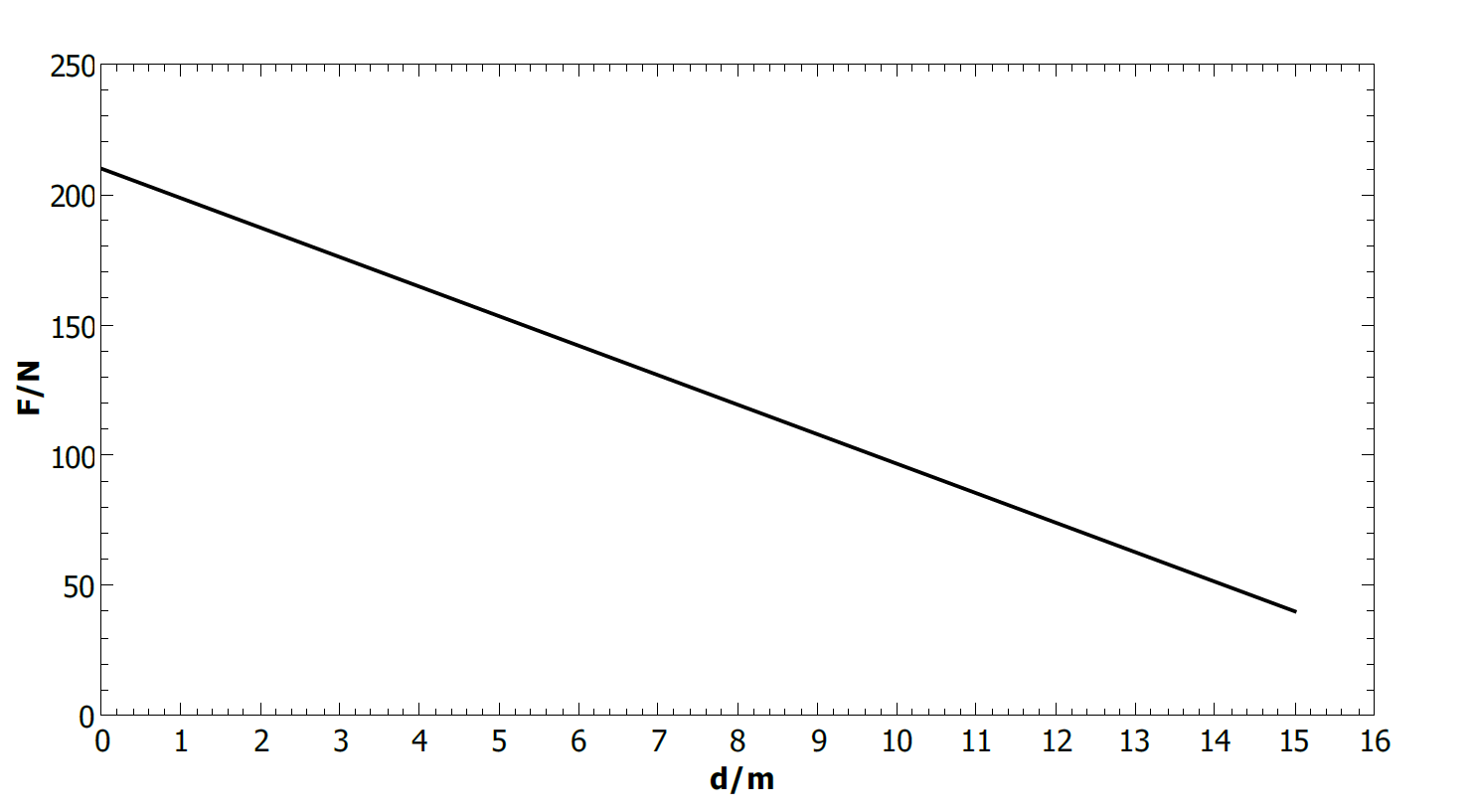All Solutions
Page 261: Practice Problems
If the same force was applied over only a half of that distance $d_2=0.075,,rm{m}$ what would the change in kinetic energy be then?
$$
E=W=Fd
$$
Inserting values we get:
$$
E=9cdot 0.15
$$
$$
boxed{E=1.35,,rm{J}}
$$
When compared with the half as great force, we can see that kinetic energy is twice as greater.
$$
E_2=W_2=Fd_2
$$
Inserting values we get:
$$
E_2=9cdot 0.075
$$
$$
boxed{E_2=0.675,,rm{J}}
$$
E=1.35,,rm{J}
$$
$$
E_2=0.675,,rm{J}
$$
Work is equal to force times distance:
$$
W=Fs
$$
$$
W=825cdot35
$$
$$
boxed{W=28875,,rm J}
$$
We can calculate this with the same equation as in part $textbf{a}$ but we put force that is doubled.
$$
W=2Fs
$$
$$
W=2cdot825cdot35
$$
$$
boxed{W=57750,,rm J}
$$
b) $W=57750,,rm$
Work is equal to force times distance. In this case force is equal to weight if the backpack.
$$
W=Fs=mgs
$$
$$
W=7.5cdot9.81cdot8.2
$$
$$
boxed{W=603,,rm J}
$$
We can use the same equation as in part $textbf{a}$ but the force is different:
$$
W=Fs=(mg+F_g)s
$$
$$
W=(7.5cdot9.81+645)cdot8.2
$$
$$
boxed{W=5892,,rm J}
$$
We can calculate average power with equation:
$$
P=frac{W}{t}
$$
In this case we have to use total work.
$$
P=frac{5892}{30cdot60}
$$
$$
boxed{P=3.27,,rm W}
$$
b) $W=5892,,rm J$
c) $P=3.27,,rm W$
$$
W=Fscosphi
$$
$$
W=250cdot30cdotcos50^o
$$
$$
boxed{W=4821,,rm J}
$$
W=4821,,rm J
$$
$$
W=2cdot Fscosphi
$$
$$
W=2cdot225cdot15cdotcos15^o
$$
$$
boxed{W=6520,,rm J}
$$
W=6520,,rm J
$$
We can use force times distance to calculate work, for distance we will use vertical distance because the force is in that direction.
$$
W=Fs
$$
$$
W=215cdot4.2
$$
$$
boxed{W=903,,rm J}
$$
We can calculate this in the same way but because the force is in the opposite orientation as path we have to put minus sign:
$$
W=Fs
$$
$$
W=-215cdot4.2
$$
$$
boxed{W=-903,,rm J}
$$
b) $W=-903,,rm J$
$$
W=Fscosphi
$$
$$
W=628cdot15cdotcos46^o
$$
$$
boxed{W=6544,,rm J}
$$
W=6544,,rm J
$$
We can find work using this equation:
$$
W=Fs
$$
$$
W=25cdot275
$$
$$
boxed{W=6875,,rm J}
$$
In this case we can use the same equation as in part $textbf{a}$ but we will use weight of the bike as force and height of the hill as distance, and because the gravity is in opposite direction as the path we have to put minus sign.
$$
W_g=-mgssin25^o
$$
$$
W_g=-13cdot9.81cdot275sin25^o
$$
$$
boxed{W_g=-14822,,rm J}
$$
When we evaluate the answer we can conclude that this problem is not possible because amount of work we put on the bike is smaller then work needed to push all the way up.
b) $W_g=-14822,,rm J$
We will start by calculating the work $W$ done by the motor. The work is given as a product of the force applied $w$ (weight) and the distance traveled $h$ (height).
$$
W=w cdot h hspace{1cm}(1)\
$$
Then the power $P$ developed is calculated by dividing the work $W$ by the time $t$ required for the work to be done. \
$$
P=frac{W}{t} hspace{1cm}(2)\
$$
$begin{aligned}hspace{3cm}
W&=w cdot h \
W&=575,text{N} cdot 20,text{m} \
W&=11500,text{J} \
end{aligned}$
$begin{aligned}hspace{3cm}
P&=frac{W}{t} \
P&=frac{11500,text{J}}{10,text{s}} \
P&=boxed{color{#c34632}1150,text{W} }\
end{aligned}$
$begin{aligned}hspace{3cm}
P&=1150,text{W} cdot frac{1,text{kW}}{1000,text{W}} \
P&=boxed{color{#c34632}1.15,text{kW}}
end{aligned}$
P=1150,text{W}=1.15,text{kW}
$$
First we have to find total work and we can do that with equation:
$$
W=Fs
$$
now we can get power from equation:
$$
P=frac{W}{t}
$$
when we connect those equations we get:
$$
P=frac{Fs}{t}
$$
$$
P=frac{145cdot60}{25}
$$
$$
boxed{P=348,,rm W}
$$
In this case the speed is doubled and that means that time is two times shorter. We can use the same equation as in part $textbf{a}$.
$$
P=frac{Fs}{t}
$$
$$
P=frac{145cdot60}{frac{25}{2}}
$$
$$
boxed{P=696,,rm W}
$$
b) $P=696,,rm W$
$$
W=Fs=mgs
$$
now we can calculate power:
$$
P=frac{W}{t}
$$
When we connect those equations we get:
$$
P=frac{mgs}{t}
$$
$$
P=frac{35cdot9.81cdot110}{60}
$$
$$
boxed{P=629,,rm W}
$$
P=629,,rm W
$$
$$
P=frac{W}{t}rightarrow W=Pt
$$
when we have work we can get force if we have distance:
$$
W=Fsrightarrow F=frac{W}{s}
$$
When we connect those equations we get:
$$
F=frac{Pt}{s}
$$
$$
F=frac{65cdot10^{3}cdot35}{17.5}
$$
$$
F=130000,,rm N
$$
F=130000,,rm N
$$
$$
W=Fs
$$
Now to calculate time we can use equation for power:
$$
P=frac{W}{t}rightarrow t=frac{W}{P}
$$
when we put the first equation in we get:
$$
t=frac{Fs}{P}
$$
$$
t=frac{6.8cdot10^{3}cdot15}{0.3cdot10^{3}}
$$
$$
boxed{t=340,,rm s}
$$
t=340,,rm s
$$
$$
W=frac{1}{2}(F_1+F_2)d
$$
$$
W=frac{1}{2}(210+40)cdot15
$$
$$
boxed{W=1875,,rm J}
$$

W=1875,,rm J
$$

